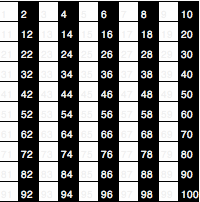Why Learn Our Times Tables?

One of the hardest maths tasks for young children (and some older ones!) is learning their times tables. A recent poll found that, even among adults, less than half were able to give a quick, confident answer to the sum: 8 x 7 = ?
As parents, you readily identify the need for your children to master their times tables because learning this is a foundation skill. It’s essential to future learning and should be mastered at an early age.
Why is it Important?
From about 7 years of age, right up to Secondary School, the times tables are the benchmark against which children often measure their maths ability.
Knowing your times tables enables you to estimate answers, to check calculator results for reasonableness, and to find short cuts.
For instance a Secondary School student who knows their times tables will “see” 24 as a number with many factors (1 x 24, 2 x 12, 3 x 8, 4 x 6). They will choose to use it over a number like 25 (that has only 1, 5 and 25 as factors) or 23 (a prime) if they’re investigating an Algebra pattern or looking for a short cut.
Breaking it down
Knowing basic facts gives an advantage, even if a calculator is used for the arithmetic. This is why the Times Tables are invaluable for teaching children multiplication and division facts.
For example, if you know that four 2’s make 8, you also know that 8 divided by 4 is 2. Your child will begin to learn their 2 and their 10 times tables in Year 2, progressing to the 3, 4 and 5 times tables in Year 3, and by Year 6 they will need to know all the times tables up to 10, sometimes 12, including the division facts.
How you can help
If you are helping your child learn their tables at home remember each new table only has a few new facts. If you know the 3 times table, you know 6 x 3 and 7 x 3, for example. Also, you can find the 8 times table by doubling the answers to the 4 times table.
Why not call or fill in our contact form for a free trial to see if we can help if your child is struggling with maths.
Image courtesy of Juanmacuevas (Processing) [GFDL or CC BY-SA 3.0], via Wikimedia Commons
